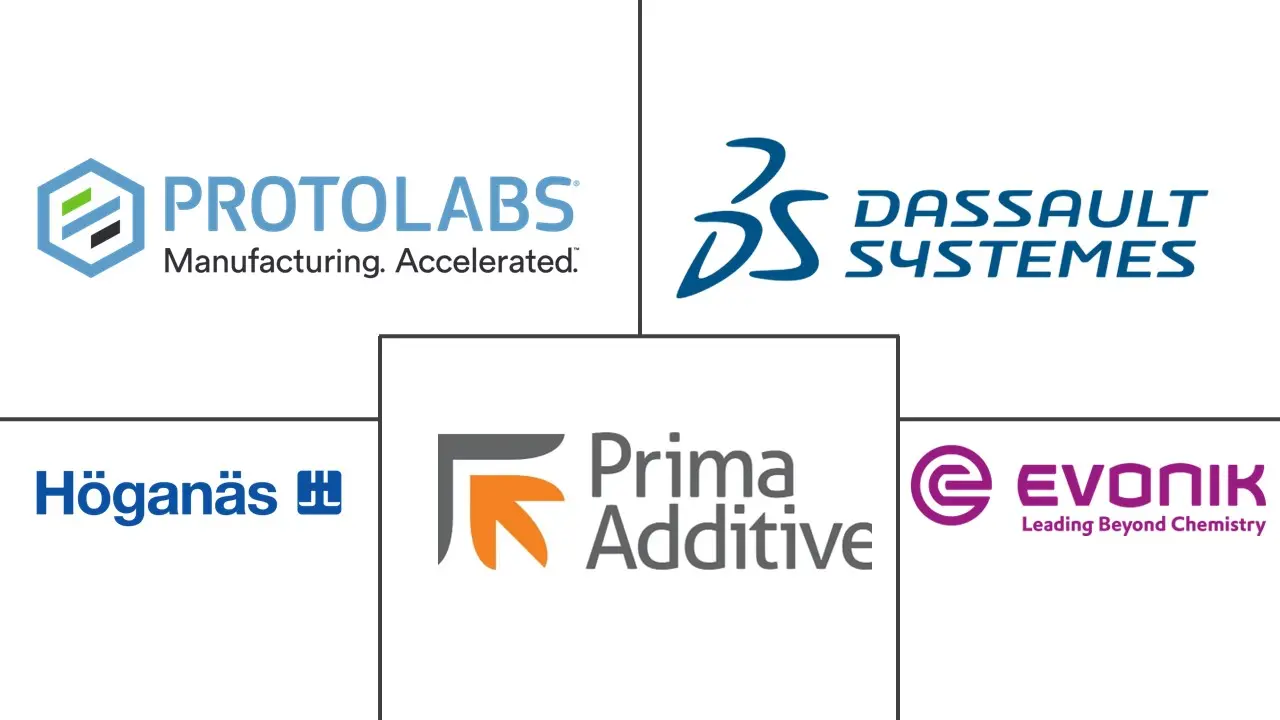Powder Bed Fusion Process 3D Printer Market Size and Share
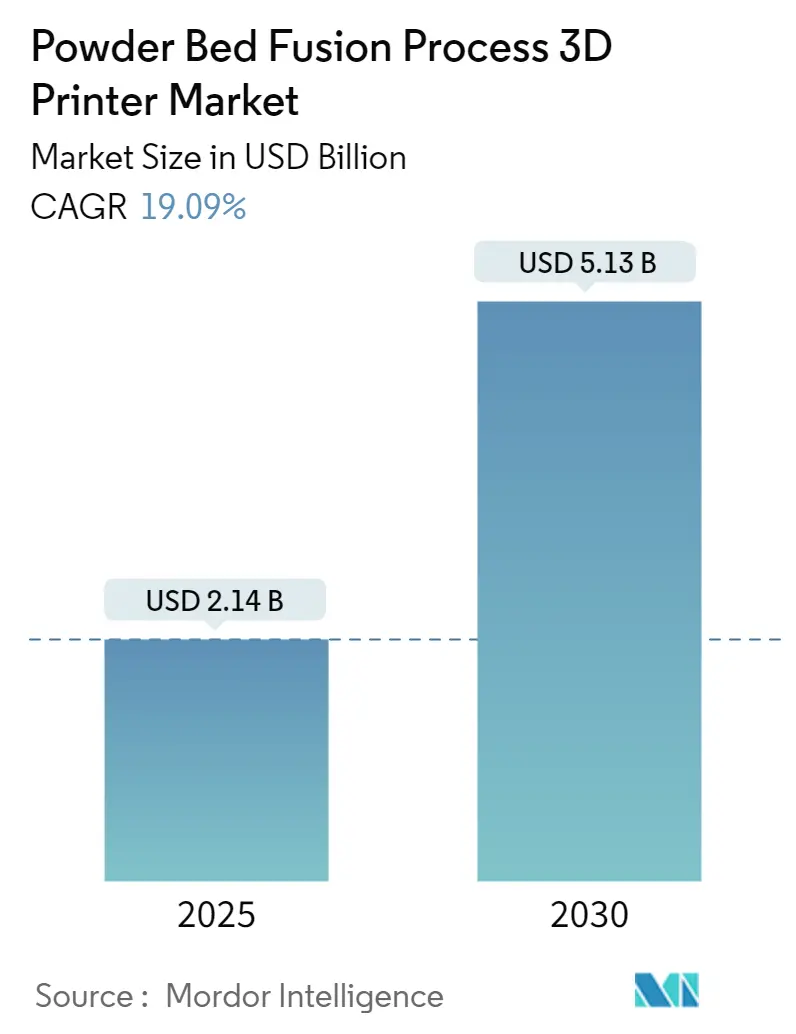
Powder Bed Fusion Process 3D Printer Market Analysis by Mordor Intelligence
The Powder Bed Fusion Process 3D Printer Market size is estimated at USD 2.14 billion in 2025, and is expected to reach USD 5.13 billion by 2030, at a CAGR of 19.09% during the forecast period (2025-2030).
Over the last decade, additive manufacturing has evolved from a niche technology with limited applications to a significant player in contemporary manufacturing. Among these technologies, powder bed fusion (PBF) is one of the oldest in metal additive manufacturing, having matured to cater to various industry-specific applications.
- The advantages of PBF 3D printers have solidified their prominence in metal additive manufacturing. For instance, PBF printers boast high resolution and offer a broader material selection than methods like binder jetting, enhancing their market appeal. While PBF processes traditionally faced size limitations in their build envelope, manufacturers are pushing these boundaries. For example, SLM Solutions' SLM 800 boasts a build envelope of 500x280x850mm, surpassing the maximum build volume of most metal additive manufacturing printers, indicating the potential for producing larger parts at competitive costs.
- Moreover, advancements now allow for the construction of intricate parts without support. This breakthrough not only streamlines the process by eliminating post-processing but also bypasses the "45-degree rule," which mandates support for angles under 45 degrees. This newfound freedom enhances design intricacy and control for users.
- As consumer demand for personalized products surges, the powder bed fusion 3D printing technology is poised for growth. Its capability to deliver highly customized products swiftly and cost-effectively makes it increasingly appealing to manufacturers aiming to cater to this demand.
- The rising adoption of PBF technology in healthcare can be linked to the surging demand for tailored medical devices, advancements in PBF materials, and the growing accessibility of PBF machines. Beyond these factors, PBF technology has showcased its ability to enhance patient outcomes and curtail healthcare expenses, further encouraging healthcare providers.
- Relentless technological advancements, burgeoning demand across sectors, and significant innovations are driving this upward trajectory. With ongoing developments in materials and software, the horizons of PBF 3D printing technology are broadening. Innovations include new materials like metal alloys and composites tailored for PBF, alongside software tools streamlining design and production.
- Furthermore, due to its capability to manufacture lightweight and intricate components, the aerospace and defense sector has emerged as a leading adopter of PBF 3D printing technology. As the global aerospace industry expands swiftly, the appetite for lightweight parts surges, fostering a conducive environment for the growth of the examined market.
- A notable constraint on the adoption of additive manufacturing, especially in powder bed processes, is their relatively low productivity. One strategy to boost the build rate of laser powder bed fusion (LPBF) without incurring hefty hardware modifications is tweaking process parameters.
Global Powder Bed Fusion Process 3D Printer Market Trends and Insights
Increasing Demand from the Healthcare Segment is Expected to Proliferate the Market's Growth
- As technology advances, the healthcare industry is rapidly adopting innovations to enhance patient care and outcomes. Among these innovations is the powder bed fusion machine, a groundbreaking tool transforming precision healthcare.
- In healthcare, powder bed fusion machines are primarily used to create customized implants and prosthetics. The demand for these prosthetic components is growing, driven by a surge in accidental and sports-related injuries. The 2023 Global Status Report on Road Safety by the WHO underscores the health challenge of road traffic-related deaths and injuries across the world. Furthermore, the report notes that an additional 20 to 50 million individuals experience non-fatal injuries, with a significant number facing disabilities.
- Moreover, the report highlights that nearly 92% of global road fatalities occur in low- and middle-income countries. Consequently, these regions are expected to present significant opportunities in the analyzed market. Data from the Thai RSC Accident Information Center indicates that, as of October 2023, Bangkok emerged as the most accident-prone area in Thailand, recording roughly 84,170 road accidents. This was closely followed by the Northeastern region, which saw about 81,920 accidents.
- Conventional implants and prosthetics often adopt a one-size-fits-all approach, leading to potential discomfort and limited functionality. Powder bed fusion machines empower healthcare professionals to craft implants and prosthetics that align seamlessly with a patient's unique anatomy. This advancement enhances comfort and functionality and diminishes the chances of complications and rejections.
- Beyond implants and prosthetics, powder bed fusion machines are also pivotal in producing precision surgical tools. These tools, being lightweight, durable, and ergonomic, are tailored for intricate surgeries. Leveraging 3D printing technology, healthcare professionals can devise surgical instruments that align perfectly with specific procedures, thereby minimizing errors and bolstering surgical success.
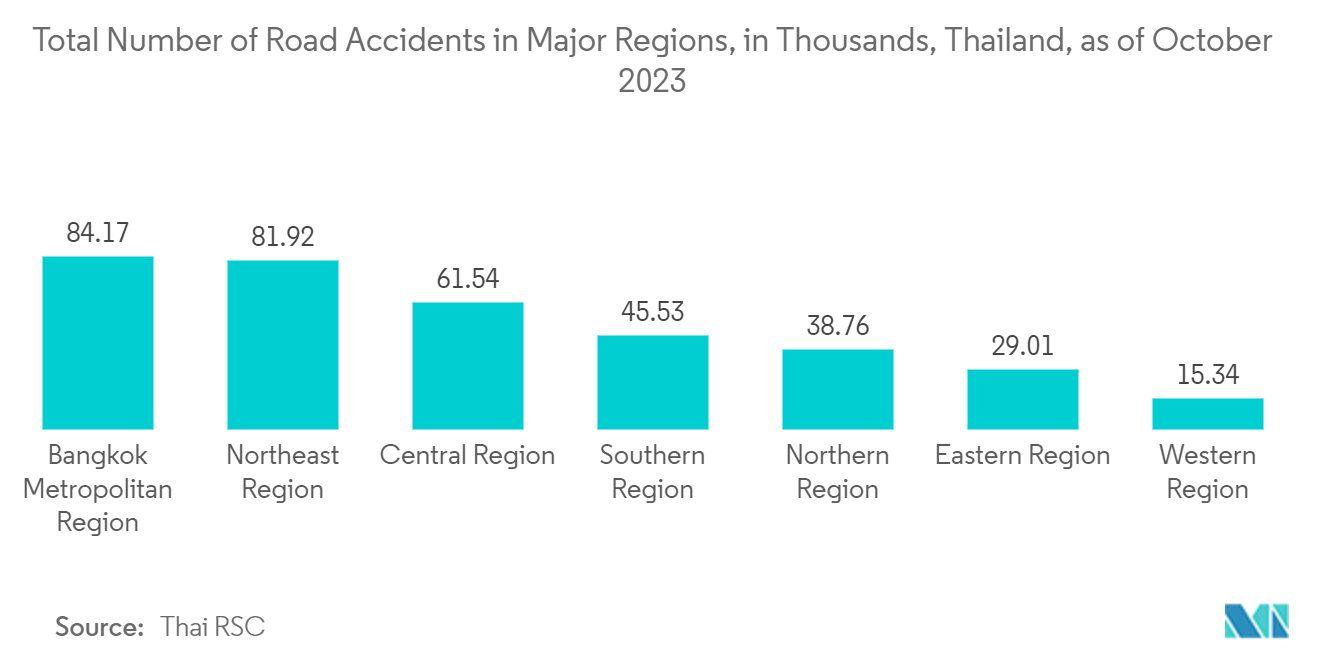
North America is Expected to Hold a Significant Share in the Market
- The United States, Canada, and Mexico are the primary drivers of the market's growth in North America. The region's demand for 3D printers utilizing the metal powder bed fusion process is anticipated to surge, fueled by the aerospace and healthcare sectors. North America's established economy sees substantial investments across diverse industries, including automotive, chemicals, tools, and molding. Notably, the region produces a significant share of the world's aerospace components, bolstered by the presence of industry giants like Boeing and Bombardier.
- Robust economic expansion and rising air travel have spurred the demand for more aircraft in the region. Within the aerospace domain, the powder bed fusion process transforms the creation of lightweight, high-strength components. Manufacturers in the aircraft and spacecraft sectors leverage this technology to produce intricate parts, like turbine blades and fuel nozzles, which are lighter and boast enhanced performance. This capability to craft parts with optimized internal structures translates to better fuel efficiency and overall operational performance in aerospace.
- North America's market growth in healthcare is bolstered by supportive government policies, a robust network of local suppliers, and a rising number of vendors specializing in healthcare products derived from the powder bed fusion process. For instance, in recent years, the US government has announced significant growth in expenditure to modernize the healthcare infrastructure, creating a favorable ecosystem for the studied market's growth.
- In the US automotive sector, the powder bed fusion process is increasingly embraced for swift prototyping and tailored automotive components. This technology, from crafting engine parts to lightweight chassis, allows automakers to rapidly iterate designs, expediting the launch of new vehicle models. Furthermore, it plays a pivotal role in electric vehicle (EV) development, where emphasizing lightweight materials and intricate designs is essential for optimizing battery efficiency and extending vehicle range.
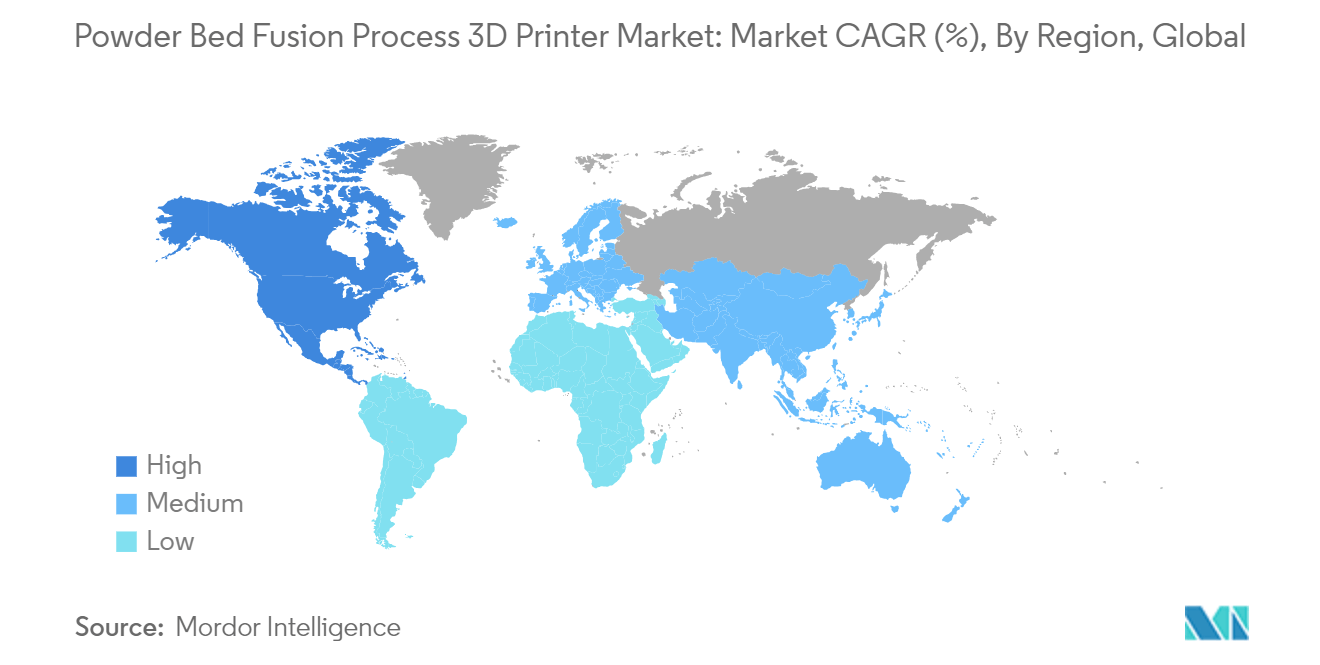
Competitive Landscape
The powder bed fusion process 3D printer market is becoming increasingly competitive, with several major vendors holding significant market shares and maintaining strong distribution networks. At the same time, new players are making their mark. Industry leaders actively engage in mergers and acquisitions and forming strategic partnerships to strengthen their foothold and broaden their reach. Such maneuvers are crucial for staying ahead in this swiftly changing landscape. Prominent players in this sector include Protolabs, Dassault Systems, Höganäs AB, and Evonik.
3D printing, a rapidly advancing technology of Industry 4.0, promises to revolutionize global manufacturing. Among various additive manufacturing techniques, powder bed fusion (PBF) stands out, especially for its adeptness in printing metal components, leading to its swift adoption across the industry. High-performance 3D-printed metal parts find applications in cutting-edge fields like architecture, aerospace, and medicine. However, the landscape is evolving. As adoption rates surge, there is a concurrent rise in expertise, enhancements in powder processing, and technological breakthroughs, all contributing to a decline in costs associated with powder-based 3D printing.
The powder bed fusion process in 3D printing is set to impact diverse sectors. Hence, vendors in the market must focus on developing a comprehensive portfolio of 3D printers targeting major current and developing application areas of powder bed fusion 3D printing process to leverage emerging opportunities from the market.
Powder Bed Fusion Process 3D Printer Industry Leaders
-
Proto Labs Inc.
-
Höganäs AB
-
Evonik
-
Prima Additive S.r.l.
-
Dassault Systemes
- *Disclaimer: Major Players sorted in no particular order
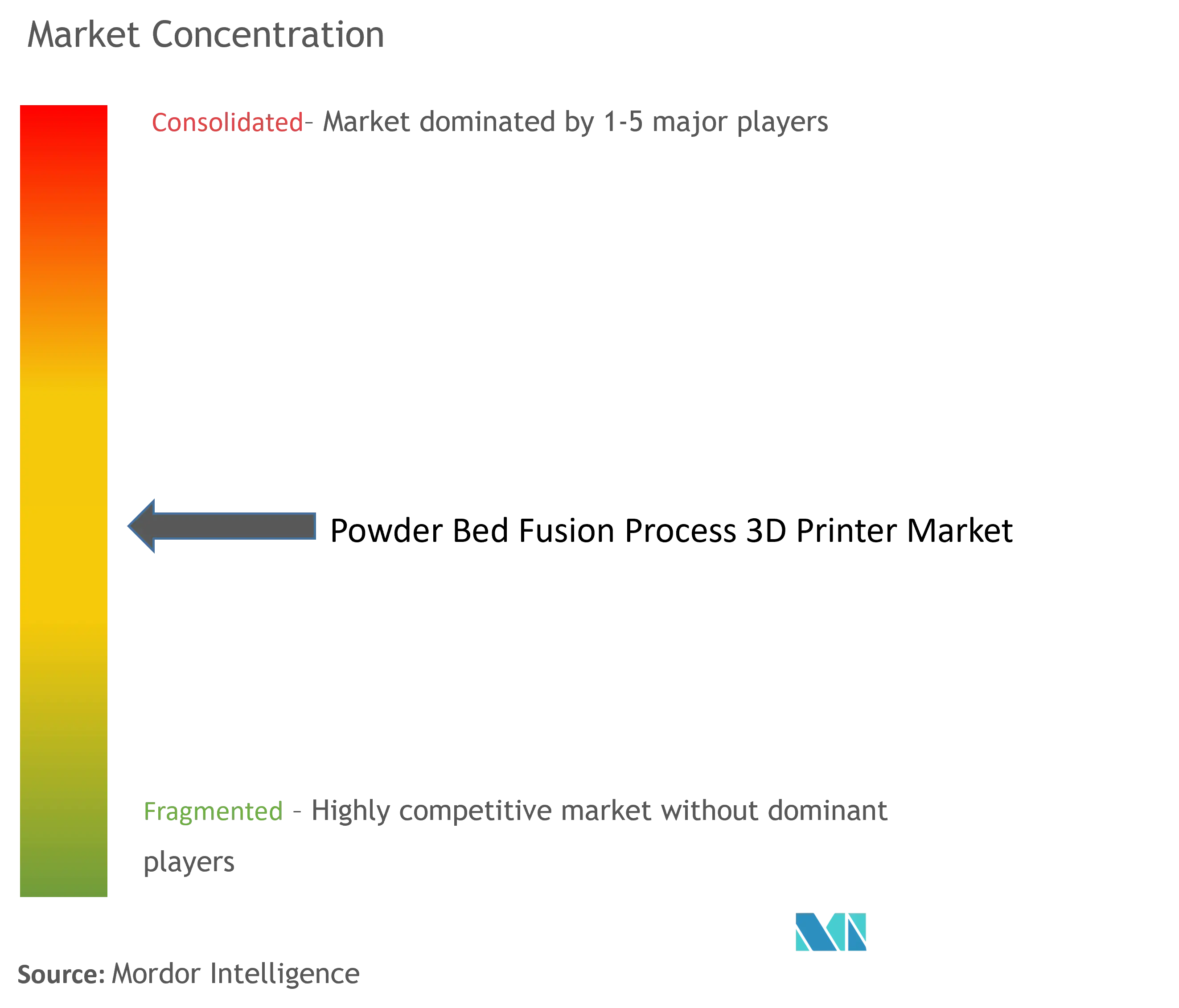
Recent Industry Developments
- June 2024: Materialise, a global frontrunner in 3D printing software and services, partnered with ArcelorMittal Powders, a division of ArcelorMittal dedicated to producing premium steel powders. The two entities signed a memorandum of understanding (MOU) aimed at enhancing laser powder bed fusion (LPBF) equipment and refining metal 3D printing strategies. As part of this collaboration, ArcelorMittal will leverage Materialise’s advanced build processor for its 3D printers.
- May 2024: Farsoon introduced its FS811M metal powder bed fusion series platform. The FS811M series features a generous build volume of 840 x 840 x 960mm and offers the flexibility of being outfitted with powerful 6, 8, 10, or 12 x 500-watt fiber lasers. As the newest entrant in Farsoon’s metal 3D printer lineup, the FS811M emerged from a collaborative innovation initiative with prominent industry partners already utilizing multiple FS621M systems.
- March 2024: Materialise unveiled its e-Stage for Metal+ software, set to debut at the Additive Manufacturing Users Group (AMUG) show. This software enhances data handling and builds preparation for laser powder bed fusion (LPBF) systems. Leveraging physics-based modeling, it automates the generation of support structures, paving the way for a more economically viable approach to metal additive manufacturing (AM).
Global Powder Bed Fusion Process 3D Printer Market Report Scope
Powder bed fusion (PBF) is a predominant 3D printing method in industrial additive manufacturing (AM). While PBF can be employed with both metals and polymers, compatibility varies across materials. The PBF process begins with a roller distributing a fine layer of powder on the build surface. An energy source then selectively melts or sinters the designated material for that layer. Once completed, the build plate descends, paving the way for the subsequent layer.
To estimate the market for powder bed fusion process 3D printers, the study tracks the revenue generated by selling powder bed fusion 3D printers by leading market vendors globally. Furthermore, it also tracks several underlying growth influencers and broader macroeconomic factors to establish the market's growth trajectory and future landscape.
The powder bed fusion process 3D printer market is segmented by type (laser powder bed fusion, electron beam powder bed fusion, and other types), by type of material supported (metal, polymer, others), end-user (aerospace and defense, automotive, healthcare, and other types of materials supported), and geography (North America, Europe, Asia-Pacific, and rest of the world). The market sizes and forecasts are provided in terms of value (USD) for all the above segments.
| Laser Poweder Bed Fusion |
| Electron Beam Powder Bed Fusion |
| Other Types |
| Metal |
| Polymer |
| Other Types of Materials Supported |
| Aerospace and Defense |
| Automotive |
| Healthcare |
| Other End Users |
| North America |
| Europe |
| Asia |
| Australia and New Zealand |
| Latin America |
| Middle East and Africa |
| By Type | Laser Poweder Bed Fusion |
| Electron Beam Powder Bed Fusion | |
| Other Types | |
| By Type of Material Supported | Metal |
| Polymer | |
| Other Types of Materials Supported | |
| End User | Aerospace and Defense |
| Automotive | |
| Healthcare | |
| Other End Users | |
| By Geography | North America |
| Europe | |
| Asia | |
| Australia and New Zealand | |
| Latin America | |
| Middle East and Africa |
Key Questions Answered in the Report
How big is the Powder Bed Fusion Process 3D Printer Market?
The Powder Bed Fusion Process 3D Printer Market size is expected to reach USD 2.14 billion in 2025 and grow at a CAGR of 19.09% to reach USD 5.13 billion by 2030.
What is the current Powder Bed Fusion Process 3D Printer Market size?
In 2025, the Powder Bed Fusion Process 3D Printer Market size is expected to reach USD 2.14 billion.
Who are the key players in Powder Bed Fusion Process 3D Printer Market?
Proto Labs Inc., Höganäs AB, Evonik, Prima Additive S.r.l. and Dassault Systemes are the major companies operating in the Powder Bed Fusion Process 3D Printer Market.
Which is the fastest growing region in Powder Bed Fusion Process 3D Printer Market?
Asia Pacific is estimated to grow at the highest CAGR over the forecast period (2025-2030).
Which region has the biggest share in Powder Bed Fusion Process 3D Printer Market?
In 2025, the North America accounts for the largest market share in Powder Bed Fusion Process 3D Printer Market.
What years does this Powder Bed Fusion Process 3D Printer Market cover, and what was the market size in 2024?
In 2024, the Powder Bed Fusion Process 3D Printer Market size was estimated at USD 1.73 billion. The report covers the Powder Bed Fusion Process 3D Printer Market historical market size for years: 2019, 2020, 2021, 2022, 2023 and 2024. The report also forecasts the Powder Bed Fusion Process 3D Printer Market size for years: 2025, 2026, 2027, 2028, 2029 and 2030.
Page last updated on:
Powder Bed Fusion Process 3D Printer Market Report
Statistics for the 2025 Powder Bed Fusion Process 3D Printer market share, size and revenue growth rate, created by Mordor Intelligence™ Industry Reports. Powder Bed Fusion Process 3D Printer analysis includes a market forecast outlook for 2025 to 2030 and historical overview. Get a sample of this industry analysis as a free report PDF download.
